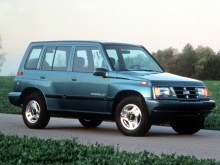Characteristics of Geo Tracker
Specifications Geo Tracker: Power, fuel consumption 100 km, weight (weight), road clearance (clearance), reversal radius, type of transmission and brakes, body sizes and tires.
Characteristics Tracker 1988 - 1997
| Modification | Power, kW (hp) / about | Fuel consumption (medium), l / 100 km | Weight (weight), kg |
|---|---|---|---|
| 2 doors 4x2 USA | (80)/- | 8.3 | 1025 |
| 2 doors 4x4 USA | (80)/- | 9.1 | 949 |
| 4 doors 4x2 USA | (95)/6000 | 9.4 | 1218 |
| 4 doors 4x4 USA | (95)/6000 | 9.4 | 1276 |
| Convertible 4x4 USA | (80)/- | 9.1 | 1069 |
| LSI 2 doors 4x2 US automatic transmission | (80)/- | 9.2 | 1030 |
| LSI 2 doors 4x2 USA | (80)/- | 8.7 | 1030 |
| LSI 2 doors 4x4 USA | (80)/- | 9.1 | 1106 |
| LSI 4 doors 4x2 USA | (95)/6000 | 9.4 | 1224 |
| LSI 4 doors 4x4 USA | (95)/6000 | 9.4 | 1290 |
| LSI convertible 4x2 USA | (80)/- | 8.7 | 1015 |
| LSI convertible 4x4 USA | (80)/- | 9.1 | 1096 |
It is easy to believe that about half of the GEO Tracker owners (Geo Tracer) make up people under 35 years old. The manufacturer positions the model as an "SUV for the active and young spirit of buyers." Those who plan to conquer off-road will please the news that Tracker is built on a steel frame of a staircase type, and the clearance is compiled 20 cm. Sunbath fans will appreciate the folding top of the open version, the manipulation of which is not labor. GEO Tracker appeared in 1989, and the only change from that moment was the appearance of a four-door closed model in 1996. A model was produced in Canada at Cami, Inc. factory - JV General Motors and Suzuki, and was also sold under the name Suzuki Sidekick.

